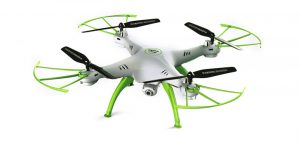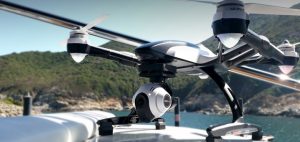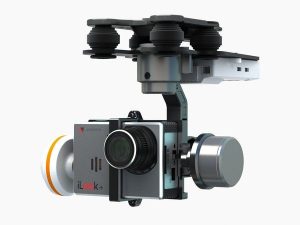Since the first models featuring it appeared last year, altitude hold has become all the rage in the toy drone segment. The feature that was once available only in more expensive drones such as the DJI Phantom 3 is now slowly becoming a standard key feature in all toy drones.
Altitude hold 101: a feature that allows a drone to autonomously maintain its altitude without throttle input from the pilot. An air pressure sensor or barometer is used by the drone to determine its altitude and the flight controller uses this reading to determine the right amount of throttle needed to maintain a fixed altitude. This is a great feature to have for beginner pilots who lack the skills needed to fly a drone in manual mode. Altitude hold frees a pilot’s attention on the throttle stick so more focus can be given to the aileron and elevator controls.

The Syma X5HW belongs to a new wave of toy drones that feature altitude hold.
Altitude hold works best in calm flying conditions where there is little to no wind currents. However, things can get a bit tricky when the wind picks up. Which is the point of this article.
When flying against strong winds, a drone’s flight controller can be tricked into thinking that it is flying at a lower altitude. For example, a drone that is flying at a height of 50 meters against a strong wind current might think it is flying at 10 or 5 meters above its launch altitude. This is because a wind current can cause a drone’s barometer to register higher than normal air pressure readings.
In some cases, if the wind is strong enough, the drone might even think it is flying 10 meters below its launch altitude. Such inaccurate readings can cause a lot of complications such as:
- ‘Malfunctioning’ Throttle Stick — Imagine flying a drone that refuses to obey your throttle inputs. Push the throttle stick all the way down and the drone simply maintains its altitude or maybe does something even more bizarre — it starts to gain altitude slowly! A drone that has flown up to 50m before getting hit by strong winds will think it is losing altitude so pushing the throttle down to zero might not cause it to descend. Instead, it might maintain its altitude or could even gain altitude.
- Disabled Auto-Land Feature — If your drone has the ‘auto-land’ feature, strong winds can render this feature useless or even plain risky. On a few occasions when I was flying in strong winds, pressing the auto-land button did nothing. In some cases, I have witnessed my drone actually gaining altitude after pressing the auto-land button — a classic example of a drone thinking it’s flying below its launch altitude.
- Choppy Flight Performance — In the days when toy drones didn’t have altitude hold, flying in windy conditions was not so complicated. With altitude hold, things have become a little bit choppy. When being hit by gusts of wind, a drone’s barometer constantly gets fed with varying degrees of air pressure, causing the drone to adjust its throttle constantly which results in a very bumpy flight.
- Plunging Flips — Toy drones generally flipped quite well, until altitude hold came along. Drones with altitude hold tend to plunge dramatically after performing flips, almost as if someone shut the throttle down to zero. This is due to a confused flight controller which sees a sudden spike in altitude readings via its pressure sensor at the start of a flip and tries to over correct the spike by dramatically reducing propulsion which causes the drone to plunge. It then takes a split second before the flight controller realizes that the drone is plunging to bring its propulsion back up again which explains the dramatic plunge.
If you’re faced with situations 1 and 2 above and think you’ve lost control of your drone, the best solution would be to perform an emergency shutdown of the motors. Shutting down the motors and just letting the drone drop down where you can easily retrieve it is a much better option than losing it in a fly away or having it crash onto someone or into a pool, etc.
With that said, I believe toy drone manufacturers really should include a button on their transmitters that allow users to turn off the altitude hold feature when needed. Until that happens, the best thing you can do is simply avoid flying when it’s very windy. If you have to fly in windy conditions, make sure you are aware of the risks and how to act when things go wrong.

